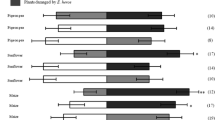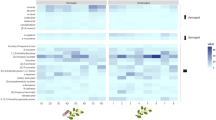Abstract
Herbivore induced release of plant volatiles mediating the foraging behavior of the aphid parasitoid Aphidius ervi was investigated using the pea aphid, Acyrthosiphon pisum, feeding on broad bean, Vicia faba. Behavioral responses were studied using an olfactometer and a wind tunnel. Volatiles obtained by air entrainment of aphid infested plants were more attractive to A. ervi than those from uninfested plants, in both behavioral bioassays. GC-EAG of both extracts showed a number of peaks associated with responses by A. ervi, but with some differences between extracts. Compounds giving these peaks were tentatively identified by GC-MS and confirmed by comparison with authentic samples on GC, using two columns of different polarity. The activity of pure compounds was further investigated by EAG and wind tunnel assays. Results showed that, of the compounds tested, 6-methyl-5-hepten-2-one was the most attractive for A. ervi females, with linalool, (Z)-3-hexen-1-yl acetate, (E)-β-ocimene, (Z)-3-hexen-1-ol, and (E)-β-farnesene all eliciting significantly more oriented flight behavior than a solvent control. Foraging experience significantly increased parasitoid responses to these compounds, with the exception of (E)-β-farnesene. Time-course GC analysis showed that feeding of A. pisum on V. faba induced or increased the release of several compounds. Release of two of these compounds (6-methyl-5-hepten-2-one and geranic acid) was not induced by the nonhost black bean aphid, Aphis fabae. During the analysis period, production of (E)-β-ocimene remained constant, but 6-methyl-5-hepten-2-one, linalool, geranic acid, and (E)-β-farnesene appeared during the first day after A. pisum infestation and increased in concentration with increasing time of aphid feeding.
Similar content being viewed by others
REFERENCES
Alborn, H. T., Turlings, T. C. J., Jones, T. H., Stenhagen, G., Loughrin, J. H., and Tumlinson, J. H. 1997. An elicitor of plant volatiles from beet armyworm oral secretion. Science 276:945–949.
Blight, M. M. 1990. Techniques for isolation and characterization of volatile semiochemicals of phytophagous insects, pp. 281–288, in A. R. McCaffery and I. D. Wilson (eds.). Chromatography and Isolation of Insect Hormones and Pheromones. Plenum Press, New York.
Bruin, J., Dicke, M., and Sabelis, M. W. 1992. Plants are better protected against spider–mites after exposure to volatiles from infested conspecifics. Experientia 48:525–529.
Bruin, J., Sabelis, M. W., and Dicke, M. 1995. Do plants tap SOS signals from their infested neighbours? TREE 10:167–170.
Buttery, R. G., and Ling, L. C. 1984. Corn leaf volatiles: Identification using Tenax trapping for possible insect attractants. J. Agric. Food Chem. 32:1104–1106.
Dawson, G. W., Griffiths, D. C., Pickett, J. A., Smith, M. C., and Woodcock, C. M. 1982. Improved preparation of (E)–β–farnesene and its activity with economically important aphids. J. Chem. Ecol. 8:1111–1117.
Dicke, M., and Sabelis, M. W. 1988. How plants obtain predatory mites as bodyguards. Neth. J. Zool. 38:148–165.
Dicke, M., Van Beek, T. A., Posthumus, M. A., Ben Dom, N., Van Bokhoven, H., and De Groot, A. 1990a. Isolation and identification of volatile kairomone that affects acarine predator prey interactions. Involvement of host plant in its production. J. Chem. Ecol. 16:381–395.
Dicke, M., Sabelis, M. W., Takabayashi, J., Bruin, J., and Posthumus, M. A. 1990b. Plant strategies of manipulating predator–prey interactions through allelochemicals: Prospects for application in pest control. J. Chem. Ecol. 16:3091–3117.
Dicke, M., Van Baarlen, P., Wessels, R., and Dijkman, H. 1993. Herbivory induces systemic production of plant volatiles that attract herbivore predators: Extraction of endogenous elicitor. J. Chem. Ecol. 19:581–599.
Du, Y.–J., Poppy, G. M., and Powell, W. 1996. Relative importance of semiochemicals from the first and second trophic level in host foraging behavior of Aphidius ervi. J. Chem. Ecol. 22:1591–1605.
Du, Y.–J., Poppy, G. M., Powell, W., and Wadhams, L. J. 1997. Chemically mediated associative learning in the host foraging behaviour of the aphid parasitoid Aphidius ervi (Hymenoptera: Braconidae). J. Insect Behav. 10:509–522.
Genstat 5 Committee. 1993. Genstat 5 Release 3 Reference Manual. Clarendon Press, Oxford.
Grasswitz, T. R., and Paine, T. D. 1993. Effect of experience on in–flight orientation to host–associated cues in the generalist parasitoid Lysiphlebus testaceipes. Entomol. Exp. Appl. 68:219–229.
Guerrieri, E., Pennacchio, F. and Tremblay, E. 1993. Flight behavior of the aphid parasitoid Aphidius ervi (Hymenoptera: Braconidae) in response to plant and host volatiles. Eur. J. Entomol. 90:415–421.
Guerrieri, E., Du, Y.–J., Poppy, G., Powell, W., Pennacchio, F., and Tremblay, E. 1996. The role of host–induced plant synomones on in–flight orientation of the aphid parasitoid Aphidius ervi Haliday (Hymenopter, Braconidae). Proceedings, XX International Congress on Entomology, Firenze, Italy, August 1996, p. 647.
Guerrieri, E., Pennacchio, F., and Tremblay, E. 1997. Effect of adult experience on in–flight orientation to plant and plant–host complex volatiles in Aphidius ervi Haliday (Hymenoptera: Braconidae). Biol. Control 10:159–165.
Johnson, A. E., Nursten, H. E., and Williams, A. A. 1971. Vegetable volatiles: A survey of components identified—Part 1. Chem. Ind. 1971:556–565.
Maddrell, S. H. P. 1969. Secretion by the Malpighian tubules of Rhodnius. The movement of ions and water. J. Exp. Biol. 51:71–97.
Mattiacci, L., Dicke, M., and Posthumus, M. A. 1995. β–Glucosidase: An elicitor of herbivore–induced plant odor that attracts host–searching parasitic wasps. Proc. Natl. Acad. Sci. U.S.A. 92:2036–2040.
ParÉ, P. W., and Tumlinson, J. H. 1997. Induced synthesis of plant volatiles. Nature 385:30–31.
Pickett, J. A. 1990. Gas chromatography–mass spectrometry in insect pheromone identification: Three extreme case histories, pp. 299–309, in A. R. McCaffery and I. D. Wilson (eds.). Chromatography and Isolation of Insect Hormones and Pheromones. Plenum Press, New York.
Pickett, J. A., and Griffiths, D. C. 1980. Composition of aphid alarm pheromones. J. Chem. Ecol. 6:349–360.
Pickett, J. A., Powell, W., Wadhams, L. J., Woodcock, C. M., and Wright, A. F. 1991. Biochemical interactions between plant–herbivore–parasitoid, pp. 1–14, in F. Bin (ed) Insect Parasitoids, 4th European Workshop, Perugia. (REDIA, Vol. LXXIV, n. 3, Appendice)
Powell, W., and Wright, A. F. 1992. The influence of host food plants on host recognition by four aphidine parasitoids (Hymenoptera: Braconidae). Bull. Entomol. Res. 74:153–161.
Powell, W., and Zhang, Z. L. 1983. The reactions of two cereal aphid parasitoids, Aphidius uzbeckistanicus and A. ervi to host aphids and their food plants. Physiol. Entomol. 8:439–443.
Powell, W., Pennacchio, F., Poppy, G. M., and Tremblay, E. 1998. Strategies involved in the location of hosts by the parasitoid Aphidius ervi Haliday (Hymenoptera: Braconidae: Aphidiinae). Biol. Control 11:104–112.
Price, P. W. 1981. Semiochemicals in evolutionary time, pp. 251–272, in D. A. Nordlund, R. L. Jones, and W. J. Lewis (eds.). Semiochemicals: Their role in pest control. John Wiley, New York.
Read, D. P., Feeny, P. P., and Root, R. B. 1970. Habitat selection by the aphid parasite Diaeretiella rapae (Hymenoptera: Braconidae) and hyperparasite Charips brassicae (Hymenoptera: Cynipidae). Can. Entomol. 102:1567–1578.
Sheehan, W., and Shelton, A. M. 1989. The role of experience in plant foraging by the aphid parasitoid Diaeretiella rapae (Hymenoptera: Aphidiidae). J. Insect Behav. 2:743–759.
Takabayashi, J., Dicke, M., and Posthumus, M. A. 1994. Volatile herbivore–induced terpenoids in plant–mite interactions: Variation caused by biotic and abiotic factors. J. Chem. Ecol. 20:1329–1354.
Tumlinson, J. H., Turlings, T. C. J., and Lewis, W. J. 1992. The semiochemical complexes that mediate insect parasitoid foraging. Agric. Zool. Rev. 5:221–252.
Tumlinson, J. H., Lewis, W. J., and Vet, L. E. M. 1993. How parasitic wasps find their hosts. Sci. Am. 268:101–105.
Turlings, T. C. J., and Tumlinson, J. H. 1992. Systemic release of chemical signals by herbivore–injured corn. Proc. Natl. Acad. Sci. U.S.A. 89:8399–8402.
Turlings, T. C. J., Scheepmaker, J. W. A., Vet, L. E. M., Tumlinson, J. H., and Lewis, W. J. 1990a. How contact foraging experiences affect preferences for host–related odors in the larval parasitoid Cotesia marginiventris (Cresson) (Hymenoptera: Braconidae). J. Chem. Ecol. 16:1577–1589.
Turlings, T. C. J., Tumlinson, J. H., Eller, F. J., and Lewis, W. J. 1990b. Exploitation of herbivore–induced plant odors by host–seeking parasitic wasps. Science 250:1251–1253.
Turlings, T. C. J., Tumlinson, J. H., Heath, R. R., Proveaus, A. T., and Doolittle, R. E. 1991. Isolation and identification of allelochemicals that attract the larval parsitoid, Cotesia marginiventris (Cresson), to the microhabitat of one of its hosts. J. Chem. Ecol. 17:2235–2251.
Turlings, T. C. J., McCall, P. J., Alborn, H. T., and Tumlinson, J. H. 1993. An elicitor in caterpillar oral secretions that induces corn seedlings to emit chemical signals attractive to parasitic wasps. J. Chem. Ecol. 19:411–425.
Vet, L. E. M. 1996. Parasitoid foraging: the importance of variation in individual behavior for population dynamics, pp. 245–256, in R. B. Floyd and A. W. Sheppard (eds.). Frontiers of Population Ecology. CSIRO Publications, Melbourne, Australia.
Vet, L. E. M., and Dicke, M. 1992. Ecology of infochemical use by natural enemies in a tritrophic context. Annu. Rev. Entomol. 37:141–172.
Vet, L. E. M., Lewis, W. J., Papaj, D. R., and van Lenteren, J. C. 1990. A variable–response model for parasitoid foraging behaviour. J. Insect. Behav. 3:471–489.
Vinson, S. B. 1985. The behavior of parasitoids, pp. 417–469, in G. A. Kerkut and L. I. Gilbert (eds.). Comprehensive Insect Physiology Biochemistry and Pharmacology, Vol. 9. Pergamon Press, Oxford.
Visser, J. H. 1983. Differential sensory perceptions of plant compounds by insects, pp. 215–230, in P. A. Hedin (ed.). Plant Resistance to Insects. ACS Symposium Series, American Chemical Society, Washington, DC.
Visser, J. H. 1986. Host odor perception in phytophagous insects. Annu. Rev. Entomol. 31:121–144.
Wadhams, L. J. 1990. The use of coupled gas chromatography:electrophysiological techniques in the identification of insect pheromones, pp. 289–298, in A. R. McCaffery and I. D. Wilson (eds.). Chromatography and Isolation of Insect Hormones and Pheromones. Plenum Press, New York.
Wadhams, L. J., Angst, M. E., and Blight, M. M. 1982. Responses of the olfactory receptors of Scolytus scolytus (F.) (Coleoptera: Scolytidae) to the stereoisomers of 4–methyl–3–heptanol. J. Chem. Ecol. 8:477–492.
Wickremasinghe, M. G. V., and Van Emden, H. F. 1992. Reactions of adult female parasitoids, particularly Aphidius rhopalosiphi, to volatile cues from the host plants of their aphid prey. Physiol. Entomol. 17:297–304.
Author information
Authors and Affiliations
Rights and permissions
About this article
Cite this article
Du, Y., Poppy, G.M., Powell, W. et al. Identification of Semiochemicals Released During Aphid Feeding That Attract Parasitoid Aphidius ervi . J Chem Ecol 24, 1355–1368 (1998). https://doi.org/10.1023/A:1021278816970
Issue Date:
DOI: https://doi.org/10.1023/A:1021278816970




